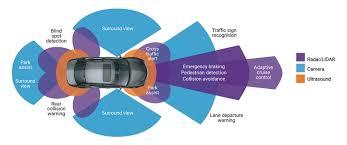Advanced Driver Assistance System (ADAS) Market: Overcoming Challenges in Technology Integration

The Advanced Driver Assistance System (ADAS) Market has been expanding at an accelerated rate in recent years, fueled by the increasing emphasis on road safety and the growing trend of autonomous vehicles. ADAS technologies are designed to improve the safety and driving experience by providing features such as lane-keeping assist, adaptive cruise control, and automatic emergency braking. However, as the integration of these technologies becomes more prevalent, there are several challenges that automakers, suppliers, and technology developers must overcome to ensure successful implementation. In this article, we explore the key challenges in the Advanced Driver Assistance System (ADAS) Market and how the industry is working to address them.
1. Sensor and Data Fusion Challenges
One of the most significant challenges in the integration of ADAS technologies is the complexity of sensor systems. ADAS relies heavily on a variety of sensors, including cameras, LiDAR, radar, and ultrasonic sensors, to collect data about the vehicle's surroundings. These sensors must work in unison to provide accurate and real-time information to the vehicle’s control systems.
The challenge lies in the need for seamless data fusion. The sensors must not only function individually but also communicate effectively with one another to create a comprehensive and reliable picture of the environment. Inconsistencies or misalignments in sensor data can lead to inaccuracies in the vehicle’s decision-making, potentially jeopardizing safety. As the Advanced Driver Assistance System (ADAS) Market grows, the industry is investing heavily in improving sensor technologies and developing more sophisticated algorithms to integrate data from multiple sources with greater precision.
2. Cost of Implementation
The implementation of ADAS technologies often comes with high costs, particularly when it comes to integrating advanced sensors and computing systems into vehicles. While premium and luxury vehicles tend to have ADAS features as standard, the cost remains a significant barrier for mass-market adoption, particularly in developing regions.
The price of integrating advanced driver assistance systems can increase the overall cost of a vehicle, limiting the affordability of such systems for consumers. This challenge is especially relevant in price-sensitive markets such as Latin America, Southeast Asia, and parts of Africa, where consumers may prioritize cost over safety features. However, as technology evolves, the cost of sensors and computing power is expected to decrease, making it more feasible to integrate ADAS into lower-cost vehicles.
Manufacturers are also exploring ways to provide ADAS as optional packages rather than as standard features to reduce the initial cost. This flexibility allows consumers to choose which safety features they value most, making ADAS technologies more accessible.
3. Standardization and Regulatory Issues
The Advanced Driver Assistance System (ADAS) Market is currently facing the challenge of a lack of uniformity in standards and regulations across different regions. Various countries have different rules regarding the testing, certification, and implementation of ADAS technologies, making it difficult for automakers to meet all regulatory requirements.
For example, the European Union, the United States, and Japan have different safety standards, which can result in significant variation in the ADAS features offered by automakers in these regions. While some countries have already mandated certain ADAS features (such as automatic emergency braking in the U.S. and lane-keeping assist in Europe), others are still in the process of introducing such regulations.
The lack of global standardization can create challenges for automakers, particularly those with international operations. To navigate this, there is a growing push for harmonized regulations and universal standards to facilitate the widespread adoption of ADAS technologies. Collaboration between governments, industry stakeholders, and standardization bodies will be key to overcoming this barrier and ensuring consistent and safe ADAS implementations worldwide.
4. Consumer Awareness and Adoption
Despite the growing focus on road safety, there is still a significant portion of consumers who are not fully aware of the benefits of ADAS technologies or how they work. Many drivers are unfamiliar with the capabilities of systems like lane departure warning or adaptive cruise control, leading to hesitancy in adopting these technologies, even if they are available in vehicles.
Automakers and technology developers need to invest in consumer education and outreach efforts to raise awareness about the benefits of ADAS systems. Demonstrating how these features can enhance safety, improve the driving experience, and ultimately save lives is crucial for driving consumer adoption. Furthermore, automakers need to ensure that these technologies are user-friendly and intuitive, as complex or confusing systems may discourage consumers from fully embracing them.
5. Cybersecurity and Data Privacy Concerns
As ADAS technologies become more integrated into vehicles, the amount of data generated by sensors and cameras increases significantly. This data is essential for the proper functioning of ADAS, but it also raises concerns about cybersecurity and data privacy. The more connected a vehicle is, the greater the risk of cyberattacks, which could compromise the safety of the vehicle and its occupants.
Cybersecurity experts and automakers must work together to develop robust security protocols to protect vehicles from hacking and unauthorized access. Additionally, manufacturers must ensure that consumer data is handled responsibly and securely, adhering to privacy laws and regulations in different regions.
Conclusion
While the Advanced Driver Assistance System (ADAS) Market presents significant growth opportunities, overcoming the challenges associated with technology integration is crucial for ensuring its continued success. By addressing issues related to sensor fusion, cost, regulatory differences, consumer awareness, and cybersecurity, the industry can continue to evolve and provide safer, more efficient vehicles to consumers worldwide. As technology advances and costs decrease, we can expect ADAS features to become more widespread, contributing to the broader adoption of autonomous vehicles and safer roads in the future.
- Art
- Causes
- Crafts
- Dance
- Drinks
- Film
- Fitness
- Food
- Games
- Gardening
- Health
- Home
- Literature
- Music
- Networking
- Other
- Party
- Religion
- Shopping
- Sports
- Theater
- Wellness


